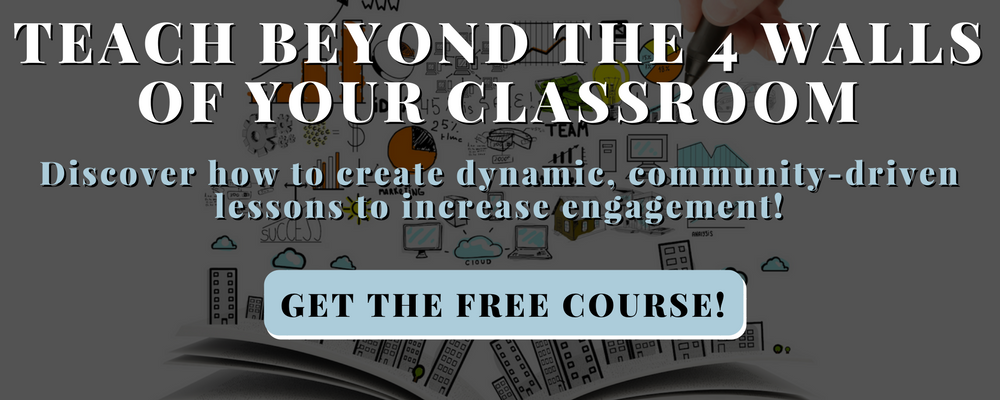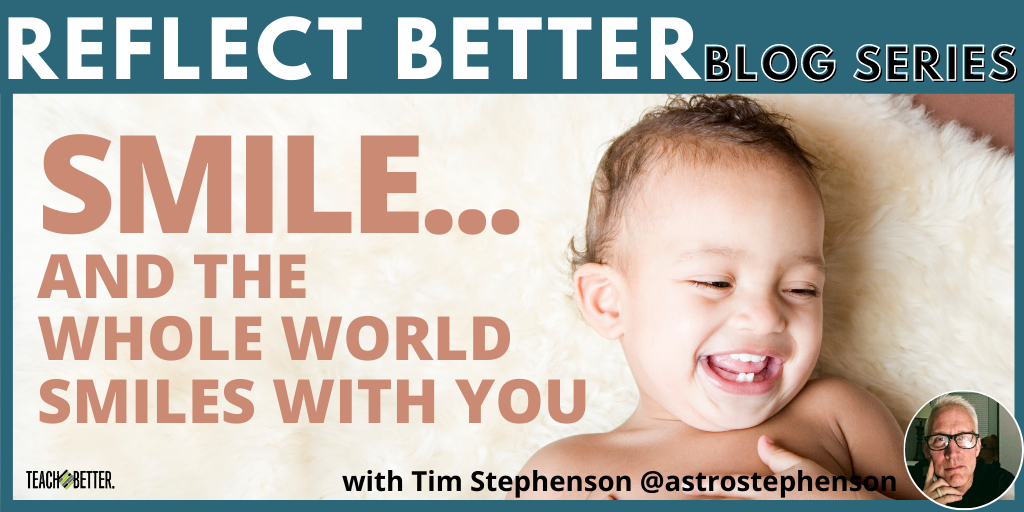TL;DR:
- Being a great speaker is all in the delivery. But it’s not just how you speak, it’s about what you say.
- Build connections with students and earn their respect by giving a smile, being real, and valuing the time you have with them.
- You may not always have an influence on students right away. Sometimes they don’t come around until the end of the year.
- Teachers also need to have their own experiences to learn from. Make a list of things you’ve always wanted to do and start checking things off.
I once had a teacher ask me to come into his classroom to promote a club and he said something odd to me. He said, “come into my classroom and give them one of your famous Stephenson rants.” That sounded a bit like a demeaning remark, but it turned out it actually wasn’t.
He literally wanted me to rev them up to get involved in school and he thought I could do that better than he could. So I went in and gave it my best shot. I think it worked because we got kids to show some interest in getting involved. I gave them my standard line, “it’s not about what you GET at school, it’s about what you DO.” They ate it up.
Smile, be real, and recognize the value of time spent in the classroom with the students you’re teaching. Don’t expect their respect. Earn it by respecting them first. Click To TweetThe value of speaking is in the delivery.
Jim Rohn used to describe great speech givers as being able to convince the masses to march into battle, even if it meant death. Think of Winston Churchill:
“…we shall not flag or fail. We shall go on to the end. We shall fight in France, we shall fight on the seas and oceans, we shall fight with growing confidence and growing strength in the air, we shall defend our island, whatever the cost may be…we shall fight on the beaches, we shall fight on the landing grounds, we shall fight in the fields and in the streets, we shall fight in the hills, we shall never surrender.”
Such powerful language! Don’t say to me that a crowd gathered to listen to that speech was bored or disinterested. This speech had punch, emotion, a rich choice of words, and a dynamic delivery.
Now, of course, we aren’t motivating our students to die for their country, and comparing our classroom speeches to Winston Churchill’s speeches may not be a fair comparison. But let’s not throw away the quest for a great speaking ability. I assure you the value is in the delivery.
Becoming a great speaker.
Then how does one go about becoming a great speaker? You may not be born that way, so how do you develop into one? I’ll start with the easiest of solutions. Start by being yourself. Don’t try to be Churchill or Kennedy or MLK Jr. Just be yourself. You can’t put on airs that suggest that you’re better in some way or that your experience demands the masses to respect you. You don’t tell your class to respect you—you have to earn that. So how do you do it?
Step 1: Smile.
Smile and then stop at as many desks as possible and ask things like:
- How are you doing?
- Tell me about your day.
- Did you get that test back in that other class? How’d it go?
- Hey, I missed you last class…were you okay?
- Are you tired? Is school getting you down? Today’s class is gonna be great. I’m making it that way just for you!
Stand there, listen to the response, and smile. Then come back to that person throughout the class. Do this with as many of your students as you can. And do it every. Single. Class.
Step one is simply to smile and treat others as you would prefer they treat you. This isn’t rocket science. It’s called the Golden Rule and I didn’t make this up!
But how many classes do you see where the philosophy is that there isn’t time for that sort of thing because there’s a lesson to be taught? Or that the separation between teacher and student has to be clear? That we just can’t have broken barriers or relationships that appear too personal?
To take that away reduces teaching to script or text, absent of facial cues, voice intonation, proximity, and eye contact. To learn, I must be drawn in by an emotional connection to the presentation and the presenter.
But if you can’t be Churchill, then at least smile. That’s step number one.
Smile: my reflection.
For those new to my blog, I’m writing this like a bookend to my teaching manifesto that I wrote back in the mid-90s as I started my teaching career. Now, 25 years later, I’m delving into my past and building on what I’ve learned from living the teaching life for 27 years. Flashback to me at the start of my career and my philosophy then:
“I am in the habit of being patient with the children that I work with as I attempt to move them from external to internal motivation. I want them to find ownership in their work and their goals because nothing short of that will move them closer to success. I encourage participation, I praise honest efforts, I single out individuals who have done something well, I smile at them and welcome them into my classroom. I give them resources to help them study, time to ask questions. I model effort, I show them pride in my work, I make good work ethics an enviable thing.”
Step 2: Be real.
But it seems that this is not a simple thing for a lot of teachers. They have their teacher voice, that teacher “look,” the evil eye, the way they can fold their arms and look at you over their glasses and you just know that something is wrong.
Now, of course, there IS a fine balance between being real and being that creepy teacher who gets just a little too real. I will never forget that I am the adult. I am the role model, and I am the example of the person I want them to become.
There is a separation between the teacher and the student that has to be determined. I want to be myself, but not my weekend self, the one that I let out when at home with my kids or having friends over on a Friday night. There is a school day Tim that maybe is a bit different than the “real” me.
But in class, I have always tried to be as close to the “real” me as I can be. And I do this because it serves a major purpose in modeling the type of person that an adult can be. I have always promised myself that I will be a person that shows young people what a good education can bring, that good language can be found, and that good behaviour and respect for others will be reciprocated.
Be real: my reflection.
An example from me, 25 years ago:
“I was assigned a grade eight class known for its boisterous behaviour.”
I think I was the third teacher they had that year! I felt they needed to be taught a lesson on effort. Realizing that they would be familiar with the recently released movie Aladdin, I read to them the scene where Genie brought Al into the city amidst all the fanfare and hype.
“I asked them to list what it was that made Genie’s efforts so special. It was not long before I heard responses indicating that if you do something, then do your best. Show passion and care about how you represent yourself, whether it be in front of your friends, parents, or teachers. The motto for the class became “show me you care” and weeks later, I was still hearing from them when they wanted me to know that they cared about their work.
It was a shot in the arm for a class of kids just starting out in high school. They needed to be taught that they should be concerned about what they do because it will matter as time goes on.”
Why did I take a lesson from a Disney animated film?
Because it was real to them and there was a message that they could benefit from. One thing that I will always emphasize to any teacher, young or old, is that content brought into a class, whether a video, a story, or a walk in the woods, must have a purpose. That purpose may not be obvious at first, but my job as the teacher is to make it obvious by the time I’m done. I’ll play a mainstream movie, but only if it’s going to result in some type of awareness or a lesson that I believe will edify and educate. Never in my class is it “just a video.”
Being real also means that when you come into my classroom, I am vividly aware of the responsibility that I have to these students.
This leads me to step three to becoming a great teacher, speaker, or presenter: be aware of time.
Step 3: Recognize the value of time with your students.
Realize the value of your audience. Respect their time. Another lesson I learned from Jim Rohn was that you can spend money and you can earn it back again. Similarly, you can spend time, but time cannot be retrieved. Time is more valuable than money because it’s a dwindling resource.
I know that time is precious and when I run a class, there must be added value placed into a student’s life. If they leave and are none the better for being there, then that was a waste of their time.
So, how do you add value? There is a way that guarantees value, and that is leaving the students with a feeling. Yes, a feeling!
To be honest, I can’t teach something fantastic every day. Sometimes teaching is like putting on 4 or 5 hour-long shows per day. With approximately 180 school days each year, that adds up to a lot of shows. You can’t be great in all of them. But there is one thing that you can do for sure, and that is leave them with a feeling of value, importance, and belonging. Share a smile, share concern, and listen.
As with supply and demand, if the supply of time diminishes, the value increases. Young people don’t know this as well. The older you get, the more acutely aware you become of the time that you’re given. And that time grows more and more precious with each passing year. It becomes obvious that if you don’t do that thing you’ve always dreamed about, the time will pass and so will the opportunity.
It is so important for teachers to understand that to be a great teacher, you also have to have your own experiences to learn from.
It’s never too late to start making that list of things that you have always dreamed of doing. Is it traveling? Learning to paint? Playing a musical instrument? Writing? Running 10 kilometres? Sleeping in the woods? Cooking over a fire? As a teacher, your list must be clearly defined, and as many of these as possible need to be checked off. The disciplined life is an abundant life, and an abundant life can teach lessons otherwise not possible. Start your list and then start chipping away at it. The clock is ticking!
[scroll down to keep reading]
You can influence your students.
To be a teacher of great influence, the formula is slowly coming into focus. And to reiterate, it isn’t a high-end formula. This is basic arithmetic. Smile, be real, and recognize the value of time spent in the classroom with the students you’re teaching. Don’t expect their respect. Earn it by respecting them first. Give them time, show them you care, and they will reciprocate. They will! Except when they don’t and when that happens, don’t abandon your ship!
These are processes that take time. I can’t tell you how many times over the years that it was April or May before certain students started to come around. Just as many times I’ve had the conversation with a student saying “remember back at the beginning of the year how ornery you were?” And we laugh and smile and we’re real with each other. If it doesn’t happen in the first week of the school year, don’t worry because sometimes it happens at the end. But more often than not, it does happen.
But if you will notice, a lot of what I’m saying here is the way YOU can influence the students, ultimately with the desire to bring them around to wanting to learn from you. We can place the learning in front of anyone, but to learn it, they have to WANT to. So some of these comments so far have been about influencing their desire to want to learn. That would be the teacher influencing the student. But who is influencing the teacher? That will be the topic of my next blog post.
About Tim Stephenson
Tim has been teaching in Langley British Columbia for over 25 years. He is a science teacher, particularly astronomy, which is a course he has developed into a full credit senior science course. In his school, he is known as AstroStephenson. Way back at the beginning of his teaching career, he wrote a book, really to himself, that contained his teaching philosophy. It was a project that would define his career. He is a possibility thinker, a dreamer and a doer, an innovator.
From the very beginning, he knew that he wanted to teach by putting students and relationships ahead of content, and putting experiences and emotions ahead of curriculum. The result has been a long career of rich and rewarding experiences for both himself and his students, the pinnacle being in 2018 when he was the recipient of the Prime Minister’s Award for Teaching Excellence.
Now Tim would like to share with you his thoughts and experiences on teaching with the hope that by reflecting better, you will feel empowered to try new things, teach in new ways and see the possibilities that are there for all of us in the teaching profession.



